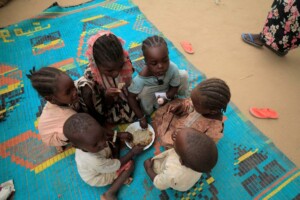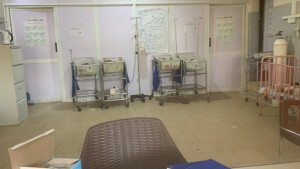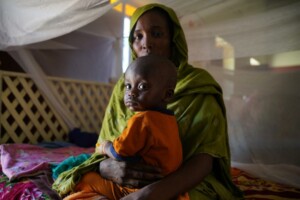We Communicate For Happy Children
 The War in Sudan: A carnage of children
The War in Sudan: A carnage of children 
Ever since the onset of the armed conflict in Sudan in April 2023, the country is still going through a worsening catastrophe due to a plethora of crises accumulated over the years. The war erupted between the two military factions in the country: the Sudanese Armed Forces led by Transitional Sovereignty Council Chairman Abdel Fattah al-Burhan, and the Rapid Support Forces led by Deputy Chairman of the Council Mohamed Hamdan Dagalo (known as Hemedti). The two generals had united to seize power following the coup on October 25th, 2021 against the civilian government. This happened two and a half years after the ousting of former Sudanese President Omar al-Bashir in April 2019.
Despite declaring a temporary ceasefire and signing the “Jeddah Declaration” in Saudi Arabia, whereby both parties committed to ensuring the protection of civilians at all times and allowing the passage of humanitarian aid in addition to a temporary ceasefire on May 29th, 2023, violations continued to occur. The rising death toll surpassed 676 dead and 5,576 wounded as of May 15th, according to the United Nations, or 700 deaths according to the Ministry of Health. The actual number of casualties is likely much higher, as there are reports of missing persons and unburied bodies, per Reuters. The non-governmental organization Armed Conflict Location and Event Data Project (ACLED) , which collects and analyzes crisis data and maps, stated that the number of fatalities reached 1,800 as of May 19th. Currently, international organizations find it challenging to access Sudan and monitor the situation, according to information from the Arab Network for Early Childhood Development.

Sudanese children who fled violence in Darfur eat breakfast next to makeshift shelters near the border between Sudan and Chad in Kafroun. May 11, 2023 (Reuters)
Whenever a conflict or crisis of any kind occurs, children are the ones who suffer the most. In this context, the United Nations Children’s Fund (UNICEF) warned that the Sudan conflicts are claiming the lives of children in “large and terrifying numbers,” citing reports indicating the death or injury of seven children every single hour. Until May 4th, the organization received reports of 190 children killed and 1,700 others injured in Sudan, but they were unable to verify the estimates due to the intensity of the violence. At least 50 children, including dozens of infants, have died at the Al-Ma’iquama Orphanage, the largest orphanage in Khartoum, due to malnutrition since the current conflict began, as the majority of staff were unable to access the facility. At least thirteen of them died on May 26th alone. Additionally, a shell hit the vicinity of the orphanage, causing severe trauma to the children. With the clashes still ongoing, it is likely that the number of child casualties will continue to rise.
Meanwhile, UNICEF announced that the number of children in need of relief in Sudan has reached an unprecedented level, surpassing 13.6 million, which is the highest number ever recorded in the country. Before the conflict, the number of children in need of humanitarian assistance was approximately 9 million.
UNICEF announced that the attacks undermine its personnel’s ability to reach children throughout Sudan with life-saving supplies and services, including health, nutrition, water, and sanitation services, calling for an end to violence. This includes a cessation of all attacks on health facilities, schools, and the water and sanitation infrastructure on which children depend.
Despite the “Jeddah Declaration” emphasizing the need to refrain from recruiting and using children in hostilities, children in conflict areas are prone to recruitment. UNICEF and child-focused non-governmental organizations, such as World Vision and Save the Children, had previously warned that violent events expose children to such grave violations.
The conflict has caused record displacement waves, reaching a total of 936,000 displaced persons as of May 15th. While there are no precise reports on the number of internally-displaced persons due to ongoing hostilities, according to the United Nations Office for the Coordination of Humanitarian Affairs (OCHA), this number has exceeded 736,200 people, including 368,000 children. Outside the country, there are approximately 220,000 displaced persons, including around 82,000 children, which is more than double what the United Nations High Commissioner for Refugees (UNHCR) announced on May 2nd.
Those fleeing have sought refuge in Egypt, South Sudan, Ethiopia, Chad, and the Central African Republic, according to the United Nations. Egypt has witnessed the largest influx of refugees. Per Human Rights Watch, Egyptian authorities require entry visas for males aged 16 to 50. This delays or prevents individuals within this age group from entering Egypt, resulting in family separations.
Chad, located in the west of Sudan, has received 60,000 refugees as of May 12th, with 30,000 of them arriving in the past week. Obtaining an entry visa for Chad takes several days or weeks. Human Rights Watch mentioned that the roads are not safe for thousands attempting to cross from West Darfur to Chad, and escapees face risky checkpoints, extortion, looting, and fear being caught in the line of fire.
According to UNHCR, approximately 90% of refugees are children and women, including pregnant women. The agency has urged the processing of all requests submitted by Sudanese and others, including stateless individuals, calling for the suspension of forced returns to Sudan.
Before the outbreak of the current fighting, Sudan had 3.7 million internally displaced persons. UNHCR has announced that, in light of the increasing number of refugees, it needs, as a preliminary estimate, $445 million with its partners to provide support for the refugees until October. Save the Children organization highlighted that children fleeing violence in Sudan to South Sudan and Egypt are under extreme pressure, leading to unusual behaviors. Adolescents exhibit violent behaviors such as anger, despair, and aggression. The organization also warned of the increasing hunger rate and malnutrition due to food shortages at crossing points, explaining that the hot meals provided at transit centers are insufficient for everyone, and many families are left without food.
Save the Children elaborated on trauma signs among children, as many families are exposed to the scorching sun without shade or shelter. During the activities conducted by the organization, many children associate small and ordinary noises they hear with the explosions that have occurred near them.
The organization further explained that the water scarcity leads to severe conflicts among women along the crossing areas, fearing that the situation will worsen as the transit center is fully occupied, and many families seek refuge on the roadside.

Dozens of children have died in Sudan’s largest orphanage due to malnutrition since the fighting began. The number of children in need of relief in Sudan exceeded 13.6 million (Photo: Dr. Abdullah Kenani, Reuters)
During the past month, the destruction of health, water, and communication facilities has worsened. At the top of the risk list is the increasing food insecurity, with the World Food Program predicting that an additional 2 to 2.5 million people in Sudan will suffer from hunger as a result of the violence. This will take the severe food insecurity there to record levels, affecting more than 19 million people.
UNICEF reported the highest rate of child malnutrition in the world, with approximately three million children in Sudan under the age of five suffering from malnutrition, including 610,000 children suffering from severe acute malnutrition. Aid suspension has disrupted treatment programs for 50,000 children suffering from severe acute malnutrition, putting their lives at risk. On May 14, the only factory producing therapeutic food for malnourished children in Sudan was burned down, destroying the supplies needed to treat 14,500 children. The factory produced 60% of the ready-to-use therapeutic food used by UNICEF for the treatment of severely malnourished children, in addition to ready-to-use complementary foods provided by the World Food Program for children with moderate acute malnutrition. This happened days after the signing of the “Jeddah Agreement” and its commitment to “distinguishing at all times between civilians and combatants and between civilian objects and military objectives, and refraining from any attack expected to cause incidental civilian harm.”
Meanwhile, the cost of food has risen across the country, with prices of essential food items expected to increase by 25% in the next three to six months, in addition to the threat to the main agricultural season due to the conflict.
Initially, Sudan already had record numbers of people facing hunger, with the World Food Program facing a funding gap of over $300 million for its vital operations. The needs were expected to significantly increase with the current war. Despite the urgent need for the program’s services in these critical conditions, the distribution of food assistance and cash transfers had to be temporarily suspended after around 17,000 tons of humanitarian aid were looted and three of its staff members were killed in exchange of gunfire. Distribution of aid resumed later, with plans to support approximately 5 million people in Sudan with emergency food assistance and 600,000 children and women with malnutrition prevention and treatment.
Today, Sudan also suffers from a severe water shortage due to power outages, fuel scarcity, supply shortages, and the destruction of vital infrastructure. According to an updated report from the United Nations Office for the Coordination of Humanitarian Affairs (OCHA), due to the inability of water authorities to repair the damaged water treatment plants in Khartoum, more than one million people rely on unsafe drinking water from the Nile River, increasing the risks of waterborne diseases.
It is to mention that 77% of Sudanese people were living below the poverty line with an income of less than $1.25 per day per person, according to the Sudan Social Security Commission’s 2020 statistics. After the suspension of Sudan’s external debt reduction initiative following the deterioration of the economic situation at the end of 2021, the current conflict dealt a major blow to the Sudanese economy in general, and specifically to Khartoum. Internal trade routes were disrupted, threatening imports and causing a liquidity crisis. The central bank caught fire, local commercial banks closed, and ATMs went out of service. Internet connectivity, which was functioning at only 4% capacity, was also disrupted, per (OCHA).
While 77% of Sudanese population lived below the poverty line, with an income of less than $1.25 per day per person, according to the Sudan Social Security Commission in 2020, the current conflict has dealt a major blow to the economy in Sudan as a whole, and particularly in Khartoum, after the external debt relief initiative collapsed following the deterioration of economic conditions at the end of 2021. Internal trade routes have been disrupted, threatening imports and causing a liquidity crisis. The Central Bank caught fire, local commercial banks closed, and ATMs went out of service. The internet connection, operating at only 4% capacity, was also disrupted, according to the United Nations Office for the Coordination of Humanitarian Affairs.
Infrastructure, major factories, economic facilities, as well as shops and markets, especially in Khartoum, have been destroyed or looted. The displacement of workers due to the war has affected production, particularly in the agriculture and manufacturing sectors, which were already facing significant challenges. Moreover, there has been a rapid increase in arbitrary economic decisions, such as deposing the Central Bank Governor Hussein Yahya Jangoul from his position and the appointment of Burai Alsadig Ahmed without mentioning the reason.
The current deteriorating humanitarian and economic situation comes after over two years since the military coup in 2021, during which humanitarian needs throughout Sudan boomed, according to the World Health Organization. The organization has mentioned prolonged displacement, increasing crime rates, and lack of security in parts of Darfur and other conflict-affected areas. Unprecedented levels of acute food insecurity have been exacerbated by irregular rainfall and drought periods, as well as high inflation of food, fuel, and other essential commodities. Floods and disease outbreaks have led to record numbers of people in need of humanitarian assistance. According to OCHA, the number has increased from 15.8 million (including over 8.5 million children) in November 2023 to 24.7 million in May 2023 – a 57% increase. These numbers are expected to continue rising.

A Sudanese woman examines her child who has malaria and severe diarrhea, at a food station in North Darfur
UNICEF announced that Sudan has the highest rate of child malnutrition in the world (UNICEF)
On the health front, OCHA reported that “less than 20% of health facilities in Khartoum are still operating at full capacity, with 60% of them not functioning, severely limiting access to urgent medical services for millions of people. As of May 17th, the World Health Organization recorded 30 attacks on healthcare facilities, resulting in the death of 8 people and injuring 18 others.
While the health crisis and challenges in the healthcare sector affect all Sudanese, they have a particularly profound impact on young children. The health crisis has exacerbated mortality rates due to infectious diseases preventable through vaccinations. The national immunization program has been disrupted amid the outbreak of polio, which was reported before the current conflict, with many cold chain facilities looted, damaged, or destroyed, including over one million polio vaccines according to UNICEF, and over 600,000 vaccines according to OCHA. The majority of the state’s vaccine stock stored in the main cold chain facility in Khartoum remains at risk of loss or damage due to lack of security and unstable power supply. Additionally, the central medical warehouse, containing medications and medical supplies worth millions of dollars, is fully under the control of one of the conflict parties.
The ongoing conflict has worsened the education crisis to alarming levels, as school closures have forced millions of children out of their classrooms. According to UNICEF and other organizations, this reality has left one girl out of every three girls and one boy out of every four boys unable to access education. This comes as there were already around seven million out-of-school children in Sudan before the current crisis, according to UNICEF. Furthermore, around 70% of children at the age of ten are unable to read.
According to OCHA, as of May 11th, schools and educational institutions in areas unaffected by the conflict have reopened in preparation for end-of-year examinations.
As a result of the current situation, many Sudanese girls and women are also subjected to sexual exploitation, violations, and gender-based violence, according to several reports. OCHA states that the deteriorating security situation hampers access to life-saving gender-based violence services, including gender-based violence case management, clinical management of rape (CMR), psychological support, and others.
Meanwhile, the organization mentioned that life-saving reproductive health services for approximately 219,000 pregnant women in Khartoum alone are now under threat, emphasizing the need for urgent assistance to restore emergency care, maternal support, and child treatment. A maternity hospital was attacked on May 4th. The organization explained that limited power supply, scarce medical supplies, and infrastructure damage severely impede the delivery of basic healthcare. Furthermore, essential medical supplies, including those dedicated to managing pregnancy complications, are critically depleted.
